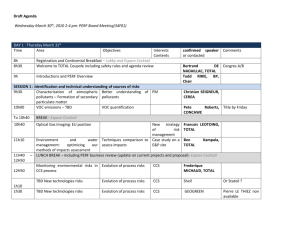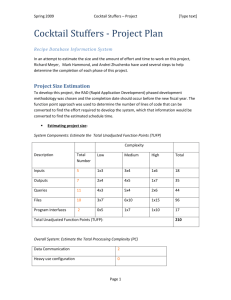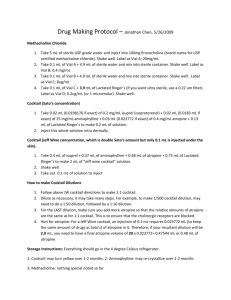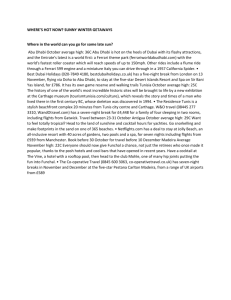Phenotyping of Human PBMC using Lyoplate
advertisement
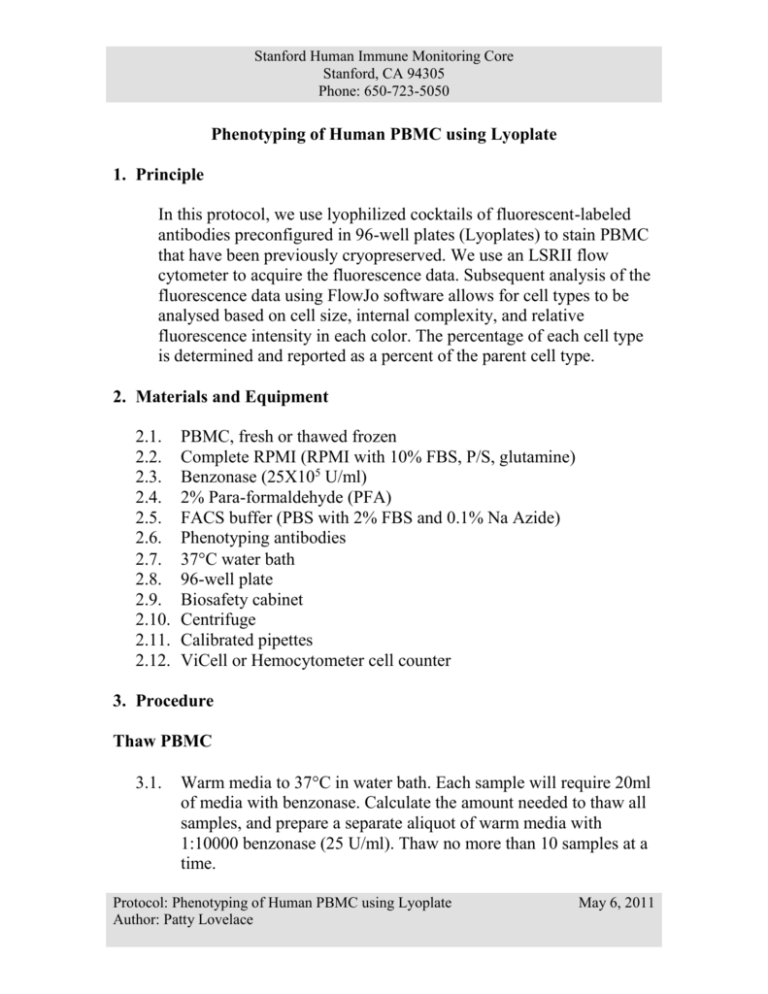
Stanford Human Immune Monitoring Core Stanford, CA 94305 Phone: 650-723-5050 Phenotyping of Human PBMC using Lyoplate 1. Principle In this protocol, we use lyophilized cocktails of fluorescent-labeled antibodies preconfigured in 96-well plates (Lyoplates) to stain PBMC that have been previously cryopreserved. We use an LSRII flow cytometer to acquire the fluorescence data. Subsequent analysis of the fluorescence data using FlowJo software allows for cell types to be analysed based on cell size, internal complexity, and relative fluorescence intensity in each color. The percentage of each cell type is determined and reported as a percent of the parent cell type. 2. Materials and Equipment 2.1. 2.2. 2.3. 2.4. 2.5. 2.6. 2.7. 2.8. 2.9. 2.10. 2.11. 2.12. PBMC, fresh or thawed frozen Complete RPMI (RPMI with 10% FBS, P/S, glutamine) Benzonase (25X105 U/ml) 2% Para-formaldehyde (PFA) FACS buffer (PBS with 2% FBS and 0.1% Na Azide) Phenotyping antibodies 37C water bath 96-well plate Biosafety cabinet Centrifuge Calibrated pipettes ViCell or Hemocytometer cell counter 3. Procedure Thaw PBMC 3.1. Warm media to 37C in water bath. Each sample will require 20ml of media with benzonase. Calculate the amount needed to thaw all samples, and prepare a separate aliquot of warm media with 1:10000 benzonase (25 U/ml). Thaw no more than 10 samples at a time. Protocol: Phenotyping of Human PBMC using Lyoplate Author: Patty Lovelace May 6, 2011 Stanford Human Immune Monitoring Core Stanford, CA 94305 Phone: 650-723-5050 3.2. 3.3. 3.4. 3.5. 3.6. 3.7. 3.8. 3.9. 3.10. 3.11. 3.12. 3.13. 3.14. 3.15. Remove samples from liquid nitrogen and transport to lab on dry ice. Place 10ml of warmed benzonase media into a 15ml tube, making a separate tube for each sample. Thaw frozen vials in 37C water bath. When cells are nearly completely thawed, carry to hood. Add 1ml of warm benzonase media from appropriately labeled centrifuge tube slowly to the cells, then transfer the cells to the centrifuge tube. Rinse vial with more media from centrifuge tube to retrieve all cells. Continue with the rest of the samples as quickly as possible. Centrifuge cells at 1400 rpm (RCF=390) for 8 minutes at room temperature. Remove supernatant from the cells and resuspend the pellet by tapping the tube. Gently resuspend the pellet in 1ml warmed benzonase media. Filter cells through a 70 micron cell strainer if needed (i.e. if you observe any clumps). Add 9ml warmed benzonase media to the tube to make volume 10ml altogether. Centrifuge cells at 1400 rpm (RCF=390) for 8 minutes at room temperature. Remove supernatant from the cells and resuspend the pellet by tapping the tube. Resuspend cells in 0.5ml FACS buffer. Count cells with Vicell (or hemocytometer). To count, take 20ul cells and dilute with 480ul PBS in vicell counting chamber. Load onto vicell as PBMC with a 1:25 dilution factor. Adjust the cell concentration to 10 * 106 cells/ml with FACS buffer. Note-it is typical to recover 4-8 * 106 cells from a vial frozen at 10 * 106 cells/vial. Up to 10 * 106 cells, no need to dilute more, just leave in 0.5 ml FACS buffer. Stain cells 3.16 Add 50-60 µl of cells from each donor into the first 7 wells of each sample row (C-H) on the Lyoplate. [Note that you can cut the foil seal so as to only expose the rows you are using, if phenotyping fewer than 6 donors at once]. Add cells to the side of each well Protocol: Phenotyping of Human PBMC using Lyoplate Author: Patty Lovelace May 6, 2011 Stanford Human Immune Monitoring Core Stanford, CA 94305 Phone: 650-723-5050 3.17 3.18 3.19 3.20 3.21 without touching pellets and let sit for 2-3 mins, then mix up and down 5-6 times using a multichannel pipette. Avoid creating bubbles. Combine 10 drops each of positive and negative BD anti-mouse Ig CompBeads (blue and white cap dropper vials) in an empty FACS tube. Add 50 µl of the combined beads to all the compensation wells (row A and well B1). Add 10 µL each of CD85j FITC and CD28 PE antibodies into each sample well of column 1 to complete cocktail 1. Add 10 µL each of TCR FITC and PD-1 PE to each sample well of column 7 to complete cocktail 7. Incubate 45-60 minutes at room temperature with gentle shaking. Add 150 µl of FACS buffer, without pipetting up and down, and spin at 1200 rpm, 2min, @ 4˚C, for the first wash. Aspirate, resuspend in 200 µl FACS buffer & spin 1200 rpm, 2 min, @ 4˚C, for a second wash. Repeat washing with 200 µl FACS buffer for a third and fourth wash. After the 4th wash, resuspend wells in 200 µL FACS buffer, cover with foil and keep at 4˚C until ready to run on LSR II. Acquire data on LSRII. Create a new blank experiment using baseline CST settings, apply Lyoplate application settings, and apply the appropriate plate template. Specific sample ID’s are added into the plate template prior to acquiring data. Record the compensation specimen, then calculate compensation, and record the experimental samples (Record 20,000-50,000 viable events/lymphocytes per well for each experimental sample). Analyze Data 3.22 Analyze data using FlowJo software using appropriate templates created for each of the seven tubes. Adjust gates on a donorspecific basis, if necessary, to control for any differences in background or positive staining intensity. 3.23 Export the statistics for each gated population to an Excel spreadsheet. Protocol: Phenotyping of Human PBMC using Lyoplate Author: Patty Lovelace May 6, 2011 Stanford Human Immune Monitoring Core Stanford, CA 94305 Phone: 650-723-5050 A 1 Empty 2 CD161 FITC 3 CD24 PE 4 HLA-DR PerCPCy5.5 5 CD45RA PE-Cy7 6 CD16 PE-Cy7 7 CD38 PE-Cy7 B CD20 APC-H7 C Cocktail 1 Cocktail 2 Cocktail 3 Cocktail 4 Cocktail 5 Cocktail 6 Cocktail 7 D Cocktail 1 Cocktail 2 Cocktail 3 Cocktail 4 Cocktail 5 Cocktail 6 Cocktail 7 E Cocktail 1 Cocktail 2 Cocktail 3 Cocktail 4 Cocktail 5 Cocktail 6 Cocktail 7 F Cocktail 1 Cocktail 2 Cocktail 3 Cocktail 4 Cocktail 5 Cocktail 6 Cocktail 7 G Cocktail 1 Cocktail 2 Cocktail 3 Cocktail 4 Cocktail 5 Cocktail 6 Cocktail 7 H Cocktail 1 Cocktail 2 Cocktail 3 Cocktail 4 Cocktail 5 Cocktail 6 Cocktail 7 COCKTAIL 1 T cells HOLD HOLD CD4 PERCP-CY5.5 CD45 RA PE-CY7 CD27 APC CD8 APC-H7 CD3 V450 COCKTAIL 3 B cells COCKTAIL 2 COCKTAIL 4 11 CD127 Alexa 647 12 CD8 APC-H7 Treg COCKTAIL 5 COCKTAIL 6 COCKTAIL 7 10 CD27 APC CD94 FITC CD314 PE HLA-DR PERC P-CY5.5 CD16 PE-CY7 CD56 APC CD8 APC-H7 CD3 V450 CD161 FITC CD25 PE CD4 PERCP-CY5.5 CD45 RA PE-Cy7 CD127 ALEXA 647 CD8 APC-H7 CD3 V450 CD56 FITC CD16 FITC HOLD CD4 PERCP-CY5.5 CD33 PE-CY7 CD19 APC CD8 APC-H7 CD3 V450 9 CD3 V450 NK/NKT Anti-IgD FITC CD24 PE CD19 PERC P-CY5.5 CD38 PE-CY7 CD27 APC CD20 APC-H7 CD3 V450 FMO CXCR3 8 CD33 PE-Cy7 CXCR3+subsets CD56 FITC CD16 FITC CXCR3 PE CD4 PERCP-CY5.5 CD33 PE-CY7 CD19 APC CD8 APC-H7 CD3 V450 Activated T HOLD HOLD CD4 PERCP-CY5.5 CD38 PE-CY7 HLA-DR APC CD8 APC-H7 CD3 V450 Protocol: Phenotyping of Human PBMC using Lyoplate Author: Patty Lovelace May 6, 2011
